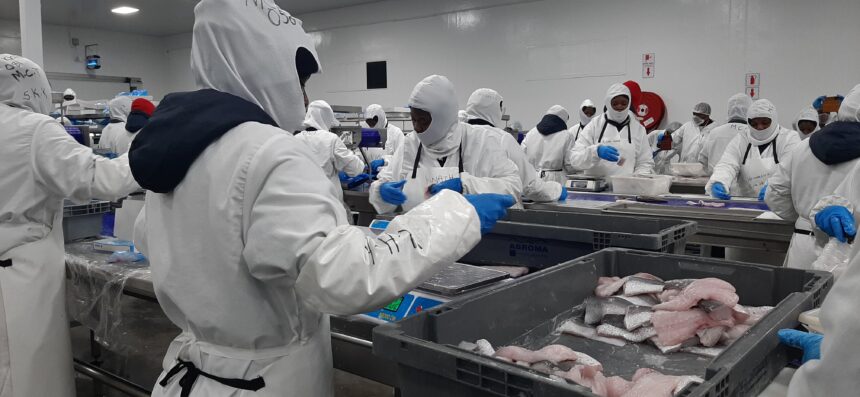WALVIS BAY – The Namibian fishing industry has evolved into a significant contributor to the country’s economy over the past 35 years, with deliberate policies aimed at ensuring sustainability, value-addition and local participation.
Today, it stands as the third-largest contributor to the national gross domestic product (GDP), generating over N$15 billion annually. Executive director of the fisheries ministry Annely Haiphene recently provided insight into the sector’s transformation, and its role in driving economic growth. She highlighted that the fishing industry remains a vital economic pillar, significantly contributing to Namibia’s GDP through employment-creation, investment and value-addition.
The sector fosters economic output by utilising fishing quotas, which are allocated and transformed along the fisheries’ value chain.
“Since 1990, deliberate policies have been implemented to enhance local fish-processing, promoting industrialisation and the development of domestic value chains,” Haiphene said.
She noted that the sector’s sustainability is at the core of its long-term viability, as Namibia has maintained its fish stocks through rigorous scientific research, ecosystem assessments and annual biomass surveys.
“We conduct annual stock assessments to determine total allowable catches (TACs), ensuring our marine resources remain sustainable. Other management measures, such as size limitations and closed fishing areas, further support stock conservation,” she added.
Haiphene said the industry plays a crucial role in Namibia’s export earnings. In 2023, the sector accounted for 14% of the country’s export revenue, amounting to N$14 billion.
Overall, the fishing sector is the second-largest foreign currency-earner after mining, with around 90% of the national fish output exported.
Spain, the Democratic Republic of Congo, Japan and China are among Namibia’s most significant markets.
Beyond economic contributions, the fishing industry has been a key employer.
The sector directly employs over 18 000 people, particularly in the hake and horse mackerel sub-sectors, which account for 70% and 17% of jobs, respectively.
“Indirect employment opportunities are also created through local fish markets, transportation and supply chains.
The industry’s growth has improved household incomes, access to education and healthcare, while also driving skills development and youth empowerment,” she noted.
Haiphene said balancing local and foreign investment remains an important aspect of Namibia’s fisheries policy, as the country has adopted a ‘Namibianisation strategy’ to ensure that quota allocations primarily benefit Namibians.
“We collaborate with the works ministry to validate vessel ownership,” she continued.
Challenges
Climate change poses a growing threat to the industry, impacting fish migration patterns and resources’ accessibility.
The rising temperatures thus push species like hake and horse mackerel into deeper, cooler waters, making them harder to catch.
“To counter this, we conduct continuous research and implement adaptive management measures, including sustainable TACs, marine protected areas and responsible fishing practices,” she noted.
Despite its successes, the industry faces challenges, including illegal, unreported and unregulated (IUU) fishing.
“IUU fishing threatens marine resources by undermining national conservation efforts. It occurs when vessels operate outside regulations, misreport catches or exploit weak monitoring systems.
This not only threatens fish stocks, but also impacts livelihoods and national food security,” Haiphene stressed.
To combat IUU fishing, the ministry has enhanced its monitoring, control and surveillance (MCS) systems.
Since 2005, all licensed fishing vessels in Namibia must be equipped with automatic location communicators (ALCs) that transmit their position, speed and direction.
“We initially set reporting intervals at four hours, but this was reduced to two hours in 2019, and one hour in 2022. This allows us to track vessel activity in real-time and enforce fishing area restrictions,” she shared.
Additionally, Namibia collaborates with neighbouring countries, including South Africa, Angola and Zambia to co-manage shared aquatic resources.
Other industry challenges include overfishing, habitat degradation and by-catch.
“We are committed to enforcing sustainable fishing practices to mitigate these risks,” she said.
Operations
During the 2023/2024 financial year, 242 vessels were licensed to operate within Namibia’s Exclusive Economic Zone (EEZ).
The executive director said the country maintains stable numbers in the different fisheries sectors, including trawlers, longliners, midwater vessels and rock lobster boats.
“As per our Namibianisation strategy, fishing quotas are only allocated to Namibian-owned entities. At present, 100% of quotas are assigned to companies with at least 51% Namibian ownership. This ensures that Namibians benefit from their marine resources,” she affirmed.
-edeklerk@nepc.com


